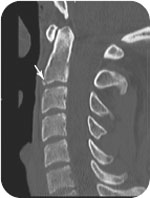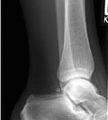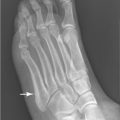George M. Bridgeforth and Mark Nolden
A 21-year-old unrestrained male driver is transported to the emergency department after a rollover motor vehicle collision.

CLINICAL POINTS
- Instability should always be assumed until proven otherwise.
- Kyphosis occurs at the level of injury in patients with flexion teardrop fractures.
- Unstable injuries may be associated with anterior cord syndrome.
Clinical Presentation
Teardrop fractures are fractures of the strike cervical spine that affect the anterior inferior end plate. The mechanism of injury may be flexion (unstable) or extension (stable). A flexion teardrop fracture is the most severe fracture of the cervical spine. Often, such injuries occur after dives into shallow pools of water. These injuries are characterized by damage to all three columns of Denis. In addition, there is a very strong association with an acute anterior cord syndrome secondary to the acute infarction of the anterior spinal artery. Patients with an anterior cord syndrome have damage to the anterior two-thirds of the spine with posterior column sparing. Therefore, they present with acute tetraplegia (quadriplegia). Spinal shock may occur. Clinically, the patients with spinal shock have low blood pressure. In addition, they manifest bilateral motor weakness below the level of the spinal cord injury, as well as loss of pinprick, sexual function, and bowel tone. However, with an anterior spinal cord injury, position sense and vibration sense are preserved because the posterior columns (fasciculus cuneatus and gracilis, which receive their blood supply from the posterior spinal artery) are spared.
In addition, secondary injuries such as associated thoracic and abdominal trauma may result. Severe sequelae such as tetraplegia may also occur. C2 through C4 tetraplegics (quadriplegics) are known as high-level tetraplegics. They have impaired respiratory function as a result of phrenic nerve damage and impaired thoracic expansion from their spinal cord injuries. If these patients survive, they remain ventilator dependent.
On the other hand, extension teardrop injuries are generally stable. There is no disruption of the posterior ligament complex. Because the posterior ligament complex is intact, there is no protrusion of the vertebral body into the spinal canal.
Radiographic Evaluation
Tests to order, for both acute cervical trauma and acute thoracolumbar trauma, include anteroposterior, lateral, and oblique views (two). In cases of cervical injury, it is necessary to see to C7. Optional radiographs include the following:
- Swimmer view, which is used to visualize the disc space between the seventh cervical vertebrae (C7) and first thoracic vertebrae (T1) if it is not identified on the lateral projection
- Flexion/extension views, which should be obtained only by experienced spinal care providers. Flexion and extension radiographs are never taken until the initial radiographs have been evaluated for instability first.
- Odontoid view (open mouth view), which is used to evaluate odontoid fractures
PATIENT ASSESSMENT 
- Acute tetraplegia (quadriplegia) in severe cases, with spinal shock
- Possible weakness, sensory loss, loss of sphincter tone, and loss of reflexes
- Posterior column sparing (light touch, vibration, and position sense remain intact despite profound weakness and loss of pinprick) in anterior spinal cord injuries
- Associated head and thoracic trauma in cervical injuries
Stay updated, free articles. Join our Telegram channel

Full access? Get Clinical Tree








